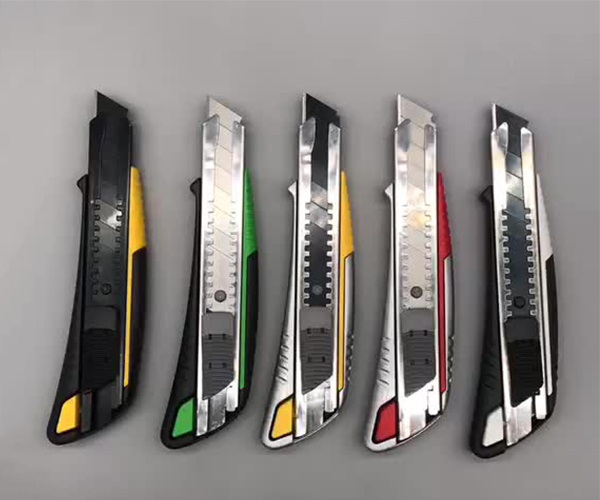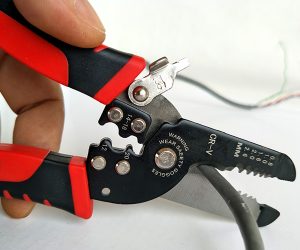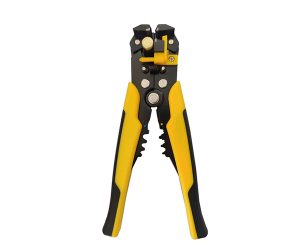When it comes to cutting tools, the box cutter and utility knife are two of the most common options. However, deciding between these two tools can be confusing, especially when you need to determine which one is the best fit for your particular task. This article will explore the differences between the two, their advantages, and when to use each one. The goal is to help you make an informed decision about which tool best suits your needs. Let’s dive in.
1. What is the Difference Between a Box Cutter and a Utility Knife?
Box cutters and utility knives are often used interchangeably, but they have key differences that make each suited for different tasks. So, what’s the real story?
A box cutter typically features a small, fixed blade designed to cut through thin materials like cardboard, plastic packaging, and paper. It’s often lightweight and easy to use for quick jobs that don’t require heavy-duty cutting. On the other hand, a utility knife is a more versatile tool that features a retractable blade, allowing users to adjust the blade length based on the job. Utility knives are generally built for tougher tasks like cutting drywall, carpet, or thick plastic.
One key feature that differentiates them is the blade design. Box cutters often have a smaller, sharper blade, ideal for precision cutting. Utility knives have a more robust design, making them capable of handling a wider variety of materials, including thicker or tougher substances.
So, which one should you choose? It really depends on what you need to cut. If you’re dealing with lightweight tasks like opening boxes, a box cutter might be sufficient. However, if you’re working with heavier materials or require more versatility, a utility knife is likely the better choice.
| Feature | Box Cutter | Utility Knife |
|---|---|---|
| Blade Type | Small, fixed blade | Retractable blade |
| Material Focus | Cardboard, light plastic | Drywall, thick plastic, wood |
| Versatility | Limited use cases | Wide range of applications |
| Blade Sharpness | Sharp, precision cuts | Adjustable blade for different jobs |
2. When Should You Use a Box Cutter?
Ready for the good part? Let’s take a closer look at when a box cutter is the right choice.
Box cutters are incredibly handy when it comes to cutting through lightweight materials. This makes them perfect for tasks such as opening cardboard boxes, cutting wrapping paper, or trimming plastic packaging. If you’re in a warehouse or office environment where packages and boxes are a daily task, the box cutter is a go-to tool.
For example, if you’re packaging or unpacking items, the box cutter will give you a clean, precise cut without the risk of damaging the contents inside. It’s also great for quickly cutting through thin plastic sheets or other flexible materials. But here’s the kicker: while a box cutter excels at precision cuts, it’s not designed for anything too heavy-duty. Trying to use it to cut through tougher materials could damage the blade or render the tool ineffective.
| Task | Best for Box Cutter |
|---|---|
| Opening cardboard boxes | Yes |
| Cutting wrapping paper | Yes |
| Trimming plastic sheets | Yes |
| Cutting thick materials | No |
3. When Should You Use a Utility Knife?
You might be wondering, when is a utility knife the better option?
A utility knife comes into play when you need a tool that can handle tougher, more demanding tasks. It’s perfect for cutting materials like drywall, flooring, carpet, or thicker plastics. Whether you’re involved in home renovation, construction, or even arts and crafts, the utility knife offers flexibility and durability.
For instance, if you’re cutting through thick carpet to lay new flooring or trimming drywall to fit a new space, the utility knife can handle the job without dulling the blade too quickly. The retractable feature allows you to adjust the blade based on your specific needs, providing better control over the cutting process. And what’s more? The blade can be replaced when it starts to lose its sharpness, ensuring you always have the right tool for the job.
| Task | Best for Utility Knife |
|---|---|
| Cutting drywall | Yes |
| Trimming carpet | Yes |
| Cutting thick plastics | Yes |
| Cutting paper or light plastic | No |
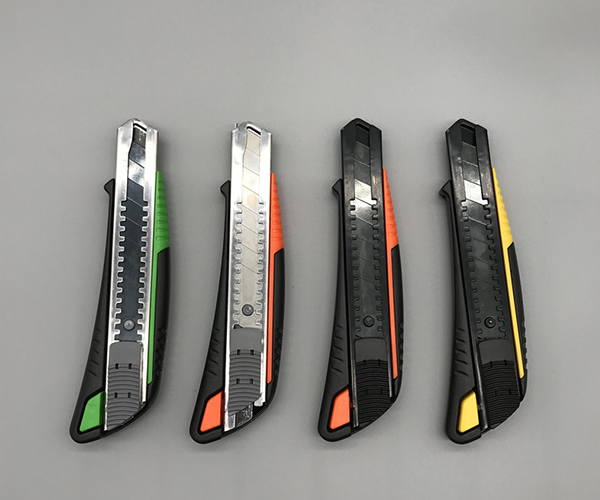
4. How Do Box Cutters and Utility Knives Compare in Terms of Safety?
Here’s the deal: safety is always a top concern when using sharp tools, and both box cutters and utility knives come with their own safety features.
Box cutters generally have a smaller blade, which makes them safer for cutting light materials. However, they can still cause injuries if not handled properly. Many box cutters are designed with a blade lock to prevent accidental exposure, and some even feature a blade cover for added protection when not in use. But here’s the kicker: because they’re used for lighter tasks, people tend to use them without thinking much about safety, which increases the risk of mishandling.
Utility knives, on the other hand, tend to be safer due to their retractable blades. With the ability to retract the blade when not in use, the risk of accidental cuts is significantly reduced. Utility knives often have a more ergonomic handle and safety mechanisms that make them easier to handle during heavier tasks. However, the retractable mechanism can wear out over time, which means the safety feature might degrade. So, it’s important to check the condition of your utility knife regularly.
| Tool Type | Blade Exposure | Safety Features |
|---|---|---|
| Box Cutter | Exposed, small blade | Blade lock, cover |
| Utility Knife | Retractable blade | Retractable mechanism, ergonomic handle |
5. What are the Pros and Cons of Box Cutters?
Let’s break it down: box cutters are great for certain tasks, but they aren’t perfect for everything.
The biggest advantage of box cutters is their simplicity and precision. They’re lightweight, easy to use, and perfect for light-duty cutting. Box cutters are ideal for tasks that require sharp, accurate cuts, like opening packages or cutting through thin plastic. They’re inexpensive and readily available, making them a popular choice for everyday use.
However, box cutters also have some drawbacks. For one, they aren’t designed for heavy-duty tasks, which means they can easily break or dull when used on tougher materials. The fixed blade also limits their versatility, and replacing the blade can be a hassle. So, what’s the real story? While box cutters are great for light tasks, they don’t hold up well under tougher conditions.
| Pros | Cons |
|---|---|
| Sharp, precise cuts | Not suitable for heavy-duty tasks |
| Lightweight | Blade not replaceable |
| Affordable | Fixed blade limits use |
6. What are the Pros and Cons of Utility Knives?
Utility knives come with their own set of advantages and disadvantages.
The primary advantage of utility knives is their versatility. They can tackle a wide range of tasks, from cutting drywall to trimming carpet. Their retractable blade design ensures that you can adjust the cutting depth, making it easier to handle various materials. The blades are also replaceable, so you don’t need to buy a new knife when the blade dulls.
But here’s the kicker: utility knives are bulkier than box cutters, which can make them less precise for fine, detailed work. They’re also more expensive upfront. And while the retractable blade is a great safety feature, it can wear down or malfunction over time, rendering it less effective.
| Pros | Cons |
|---|---|
| Versatile, multiple uses | Bulky, harder to handle for precise tasks |
| Adjustable blade depth | Higher upfront cost |
| Replaceable blades | Wear on retractable mechanism |
7. What Features Should You Consider When Choosing Between a Box Cutter and a Utility Knife?
So, you’re considering whether to go for a box cutter or a utility knife. What features should you keep in mind?
When choosing between the two, think about what you’ll be cutting most often. If you only need a tool for lightweight tasks like cutting boxes, a box cutter is likely your best bet. It’s lightweight, compact, and inexpensive, making it perfect for occasional use. On the other hand, if you’re working with tougher materials or require a more versatile tool, a utility knife is the way to go. Its adjustable blade and ability to cut through a variety of materials make it a more durable option for long-term use.
Consider the blade type as well. Box cutters generally have sharper, fixed blades, while utility knives offer more flexibility with adjustable, retractable blades. Finally, don’t forget to think about safety features, such as a locking mechanism or retractable blade, depending on your needs.
| Feature | Box Cutter | Utility Knife |
|---|---|---|
| Blade Type | Fixed, sharp blade | Retractable blade |
| Ideal for | Light tasks | Heavy-duty tasks |
| Safety Features | Locking mechanism | Retractable blade |
| Durability | Short-term use | Long-term use |
8. Which is More Affordable: Box Cutter or Utility Knife?
Let’s talk about cost—is one tool more affordable than the other?
Generally speaking, box cutters tend to be cheaper than utility knives. This makes them a great option for those on a budget or people who only need a tool for occasional use. Box cutters can be found for just a few dollars, and replacement blades are inexpensive as well.
Utility knives, on the other hand, are usually more expensive due to their versatility and replaceable blade systems. However, they offer more value in the long run because they can handle a wider range of tasks. If you’re doing more heavy-duty work, the added cost of a utility knife may be worth the investment.
| Tool Type | Price Range | Replacement Costs |
|---|---|---|
| Box Cutter | $1–$5 | Low ($1–$2) |
| Utility Knife | $5–$15 | Medium ($2–$5) |
9. How Do Box Cutters and Utility Knives Perform in Heavy-Duty Tasks?
When it comes to heavy-duty tasks, utility knives truly shine. Whether you’re cutting through thick plastic, drywall, or even carpet, a utility knife can handle the job. The adjustable blade allows you to use different depths depending on the material, ensuring you get the right cut for each task.
Box cutters, on the other hand, are not built for heavy-duty work. While they are ideal for lightweight cutting tasks like opening packages, they will struggle with thicker materials. Trying to use a box cutter for a job that requires cutting through thick cardboard or plastic could cause the blade to snap or become dull quickly.
| Task | Box Cutter | Utility Knife |
|---|---|---|
| Cutting cardboard | Yes | Yes |
| Cutting drywall | No | Yes |
| Cutting carpet | No | Yes |
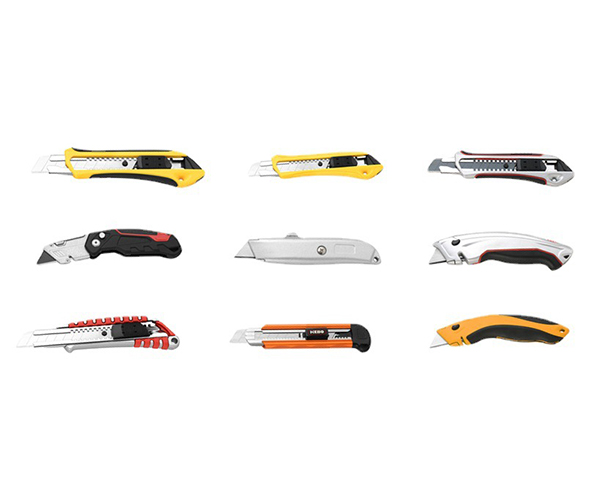
10. Can You Replace the Blades in Both Box Cutters and Utility Knives?
Yes, both box cutters and utility knives allow for blade replacements. However, the process differs slightly between the two tools. For box cutters, you’ll need to replace the entire blade when it becomes dull, and depending on the design of the box cutter, this can either be a simple or more involved task.
Utility knives, on the other hand, feature retractable, snap-off blades that allow you to simply break off the dull portion and continue cutting. This makes it much easier and more cost-effective to maintain the tool over time.
| Tool Type | Blade Replacement Process | Cost of Replacement |
|---|---|---|
| Box Cutter | Full blade replacement | Low |
| Utility Knife | Snap-off or full replacement | Medium |
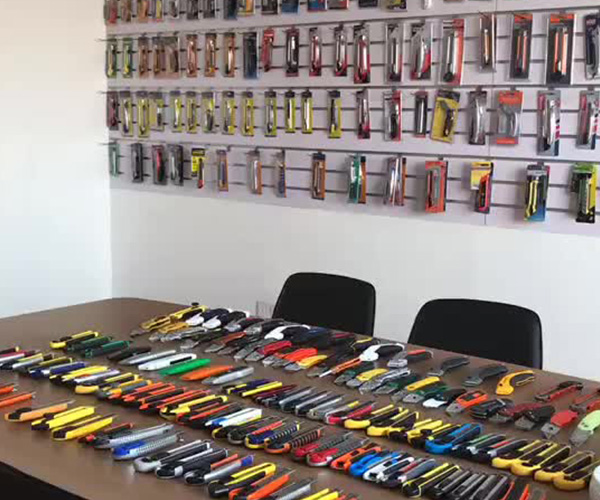
Conclusion
In conclusion, choosing between a box cutter and a utility knife depends on the tasks you need to tackle. Box cutters are ideal for light, precise cuts on thin materials, while utility knives offer versatility and durability for tougher jobs. By considering factors like safety, cost, and material needs, you can make an informed decision that best fits your cutting tasks. Whether you’re working in a warehouse, home improvement project, or arts and crafts, both tools have their strengths—so pick the one that meets your needs.
FAQ Section
Q1: What is the difference between a box cutter and a utility knife?
A box cutter has a small, fixed blade ideal for light, precise cutting, while a utility knife has a retractable blade and is suited for heavier-duty tasks.
Q2: How does a box cutter work?
A box cutter uses a sharp, fixed blade to cut through materials like cardboard and plastic packaging, making it ideal for light tasks.
Q3: When should I use a utility knife instead of a box cutter?
You should use a utility knife when cutting tougher materials like drywall, carpet, or thick plastic, as it offers more versatility.
Q4: Are box cutters or utility knives safer to use?
Utility knives are generally safer due to their retractable blades, but both tools have safety mechanisms to reduce the risk of injury.
Q5: Can the blades in box cutters and utility knives be replaced?
Yes, both tools allow for blade replacement, but utility knives offer more flexibility with snap-off blades, while box cutters require full blade replacement.

